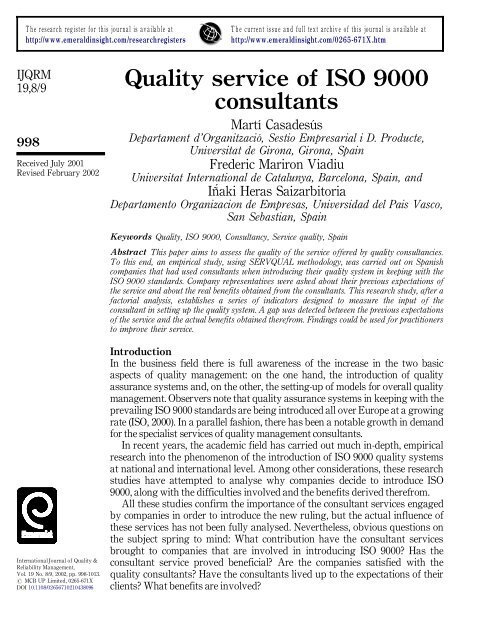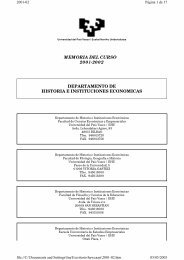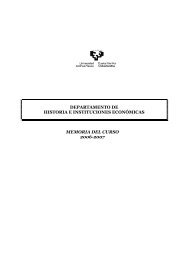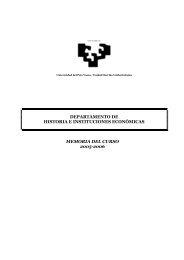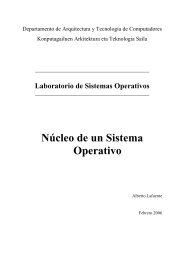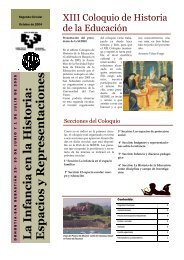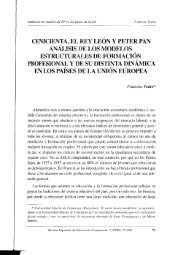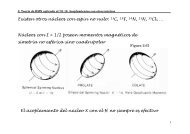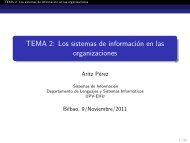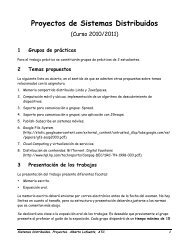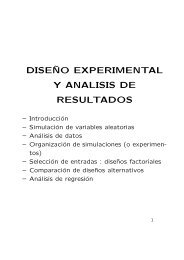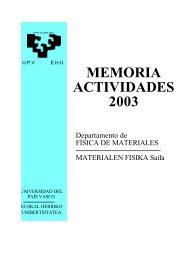Quality service of ISO 9000 consultants - Universitat de Girona
Quality service of ISO 9000 consultants - Universitat de Girona
Quality service of ISO 9000 consultants - Universitat de Girona
Create successful ePaper yourself
Turn your PDF publications into a flip-book with our unique Google optimized e-Paper software.
T h e r e s e a r c h r e g is t e r f o r t h is jo u r n a l is a v a ila b le a t<br />
http://www.em eraldinsight.com /researchregisters<br />
T h e c u r r e n t is s u e a n d f u ll te x t a rc h iv e o f th is jo u r n a l is a v a ila b le a t<br />
http://www.em eraldinsight.com /0265-671X .htm<br />
IJQRM<br />
19,8/9<br />
998<br />
Received July 2001<br />
Revised February 2002<br />
<strong>Quality</strong> <strong>service</strong> <strong>of</strong> <strong>ISO</strong> <strong>9000</strong><br />
<strong>consultants</strong><br />
MartõÂ Casa<strong>de</strong>suÂs<br />
Departament d’OrganitzacioÂ, Sestio Empresarial i D. Producte,<br />
<strong>Universitat</strong> <strong>de</strong> <strong>Girona</strong>, <strong>Girona</strong>, Spain<br />
Fre<strong>de</strong>ric Mariron Viadiu<br />
<strong>Universitat</strong> International <strong>de</strong> Catalunya, Barcelona, Spain, and<br />
InÄÂaki Heras Saizarbitoria<br />
Departamento Organizacion <strong>de</strong> Empresas, Universidad <strong>de</strong>l Pais Vasco,<br />
San Sebastian, Spain<br />
Keywords <strong>Quality</strong>, <strong>ISO</strong> <strong>9000</strong>, Consultancy, Service quality, Spain<br />
Abstract This paper aims to assess the quality <strong>of</strong> the <strong>service</strong> <strong>of</strong>fered by quality consultancies.<br />
To this end, an empirical study, using SERVQUAL methodology, was carried out on Spanish<br />
companies that had used <strong>consultants</strong> when introducing their quality system in keeping with the<br />
<strong>ISO</strong> <strong>9000</strong> standards. Company representatives were asked about their previous expectations <strong>of</strong><br />
the <strong>service</strong> and about the real benefits obtained from the <strong>consultants</strong>. This research study, after a<br />
factorial analysis, establishes a series <strong>of</strong> indicators <strong>de</strong>signed to measure the input <strong>of</strong> the<br />
consultant in setting up the quality system. A gap was <strong>de</strong>tected between the previous expectations<br />
<strong>of</strong> the <strong>service</strong> and the actual benefits obtained therefrom. Findings could be used for practitioners<br />
to improve their <strong>service</strong>.<br />
International Journal <strong>of</strong> <strong>Quality</strong> &<br />
Reliability Management,<br />
Vol. 19 No. 8/9, 2002, pp. 998-1013.<br />
# MCB UP Limited, 0265-671X<br />
DOI 10.1108/02656710210438096<br />
Introduction<br />
In the business field there is full awareness <strong>of</strong> the increase in the two basic<br />
aspects <strong>of</strong> quality management: on the one hand, the introduction <strong>of</strong> quality<br />
assurance systems and, on the other, the setting-up <strong>of</strong> mo<strong>de</strong>ls for overall quality<br />
management. Observers note that quality assurance systems in keeping with the<br />
prevailing <strong>ISO</strong> <strong>9000</strong> standards are being introduced all over Europe at a growing<br />
rate (<strong>ISO</strong>, 2000). In a parallel fashion, there has been a notable growth in <strong>de</strong>mand<br />
for the specialist <strong>service</strong>s <strong>of</strong> quality management <strong>consultants</strong>.<br />
In recent years, the aca<strong>de</strong>mic field has carried out much in-<strong>de</strong>pth, empirical<br />
research into the phenomenon <strong>of</strong> the introduction <strong>of</strong> <strong>ISO</strong> <strong>9000</strong> quality systems<br />
at national and international level. Among other consi<strong>de</strong>rations, these research<br />
studies have attempted to analyse why companies <strong>de</strong>ci<strong>de</strong> to introduce <strong>ISO</strong><br />
<strong>9000</strong>, along with the difficulties involved and the benefits <strong>de</strong>rived therefrom.<br />
All these studies confirm the importance <strong>of</strong> the consultant <strong>service</strong>s engaged<br />
by companies in or<strong>de</strong>r to introduce the new ruling, but the actual influence <strong>of</strong><br />
these <strong>service</strong>s has not been fully analysed. Nevertheless, obvious questions on<br />
the subject spring to mind: What contribution have the consultant <strong>service</strong>s<br />
brought to companies that are involved in introducing <strong>ISO</strong> <strong>9000</strong>? Has the<br />
consultant <strong>service</strong> proved beneficial? Are the companies satisfied with the<br />
quality <strong>consultants</strong>? Have the <strong>consultants</strong> lived up to the expectations <strong>of</strong> their<br />
clients? What benefits are involved?
These questions are obviously <strong>of</strong> interest to the companies involved but also<br />
to <strong>consultants</strong> eager to <strong>de</strong>termine the <strong>de</strong>gree <strong>of</strong> client satisfaction, on which<br />
their very future <strong>de</strong>pends. Moreover, the analysis <strong>of</strong> these questions is even<br />
more relevant in the present situation where companies are involved in a<br />
process <strong>of</strong> adaptation to the new <strong>ISO</strong> <strong>9000</strong>:2000 standards. For all the above<br />
reasons, and in or<strong>de</strong>r to resolve the issues thereby raised, the present empirical<br />
study was carried out on companies that have used consultancy <strong>service</strong>s to<br />
introduce their <strong>ISO</strong> <strong>9000</strong> quality systems.<br />
<strong>Quality</strong> <strong>service</strong><br />
<strong>of</strong> <strong>ISO</strong> <strong>9000</strong><br />
<strong>consultants</strong><br />
999<br />
Antece<strong>de</strong>nts<br />
Most research into quality management at a world-wi<strong>de</strong> level refers to the<br />
motivation <strong>of</strong> companies to introduce quality systems (Meegan and Taylor,<br />
1997), to the benefits <strong>de</strong>rived from the introduction <strong>of</strong> such systems (Lloyd’s<br />
Register <strong>Quality</strong> Assurance, 1994; Vanguard Consulting, 1994; Brown and Van<br />
<strong>de</strong>r Wiele, 1995; Buttle, 1997; Jones et al., 1997; Casa<strong>de</strong>suÂs and GimeÂnez, 2000),<br />
or to the importance <strong>of</strong> the human factor in quality management (Vloeberghs<br />
and Bellens, 1996).<br />
Many studies mention the importance <strong>of</strong> the support lent by consultant<br />
<strong>service</strong>s for the introduction <strong>of</strong> the ruling. In this country, previous research<br />
showed that approximately 80 percent <strong>of</strong> 286 Spanish companies surveyed use<br />
external consultant <strong>service</strong>s (Casa<strong>de</strong>suÂs, 1998). This can be seen in Figure 1.<br />
The <strong>service</strong>s provi<strong>de</strong>d range from in-<strong>service</strong> training prior to introducing a<br />
quality system to maintenance auditing <strong>of</strong> the system after certification. The<br />
<strong>service</strong> can also inclu<strong>de</strong> producing the quality manual and drawing up<br />
procedures for the quality assurance systems.<br />
In like manner, some research studies mention the relative importance <strong>of</strong><br />
companies that have used external consultancies compared with those that<br />
have not (Vloeberghs and Bellens, 1996) but no study has assessed the real<br />
quality <strong>of</strong> the <strong>service</strong>s <strong>of</strong>fered by the consultancies or whether this <strong>service</strong> was<br />
really what the client company expected. Some consi<strong>de</strong>rations on the<br />
contributions <strong>of</strong> consultant firms can be found (including factors such as<br />
employee training, information and motivation), but no studies have been ma<strong>de</strong><br />
Figure 1.<br />
Percentage <strong>of</strong> companies<br />
that have used<br />
consultant <strong>service</strong>s<br />
when introducing<br />
quality systems
IJQRM<br />
19,8/9<br />
1000<br />
on issues <strong>of</strong> such crucial interest as the following: to what extent does the<br />
engagement <strong>of</strong> a consultant <strong>service</strong> provi<strong>de</strong> benefits to the firm? Can these<br />
benefits be measured? Are the benefits <strong>of</strong> an intangible nature that is hard to<br />
express in monetary terms? This is a complex issue in<strong>de</strong>ed, as has already been<br />
pointed out in the literature on the subject (Nachum, 1999), where some authors<br />
have put forward their own methodology for calculating the yield from an<br />
investment in consultation <strong>service</strong>s (Phillips, 2000).<br />
The present paper aims to summarise the main conclusions drawn from a<br />
research study that analyses the expectations and fulfilment <strong>of</strong> expectations<br />
among client companies that have used consultancy <strong>service</strong>s to introduce <strong>ISO</strong><br />
<strong>9000</strong> quality assurance systems. The paper also analyses the benefits obtained<br />
by the companies as a result <strong>of</strong> the introduction <strong>of</strong> the ruling following advice<br />
given by pr<strong>of</strong>essional <strong>consultants</strong>.<br />
Methodology<br />
An empirical research study has been recently carried out with the aim <strong>of</strong><br />
analysing and attempting to provi<strong>de</strong> an answer to these questions. A sample<br />
was taken <strong>of</strong> companies that had used consultant <strong>service</strong>s for implementing<br />
quality assurance systems in keeping with the <strong>ISO</strong> <strong>9000</strong> standards on the<br />
subject. This mo<strong>de</strong>l or type <strong>of</strong> quality management was chosen because it is<br />
undoubtedly the most wi<strong>de</strong>ly used in Spain and also because field work is<br />
ma<strong>de</strong> easier by the existence <strong>of</strong> registers <strong>of</strong> all the companies that have been<br />
issued with the <strong>ISO</strong> <strong>9000</strong> certificate. In more specific terms, the research was<br />
carried out within the industrial area <strong>of</strong> Catalonia and focuses on companies<br />
that were certified in 1997, 1998 and 1999.<br />
The companies in the sample were sent a questionnaire, adapted from the<br />
wi<strong>de</strong>spread SERVQUAL mo<strong>de</strong>l drawn up by Zeithaml et al. (1993), for<br />
consulting <strong>service</strong>s in Spain. This is a mo<strong>de</strong>l whereby the quality <strong>of</strong> a given<br />
<strong>service</strong> is assessed on the basis <strong>of</strong> the expectations and perceptions <strong>of</strong> the<br />
clients. This is consi<strong>de</strong>red to be the best known system presently used for<br />
measuring <strong>service</strong> quality.<br />
In short, the questionnaire was <strong>de</strong>signed to gather information about the quality<br />
<strong>of</strong> the consultancy <strong>service</strong> as perceived by companies that engaged the <strong>service</strong> to<br />
introduce <strong>ISO</strong> <strong>9000</strong> and about the expectations <strong>of</strong> this type <strong>of</strong> <strong>service</strong> that were<br />
previously held by the company. With this information, the questionnaire then<br />
attempts to find out the benefits that were obtained by the company as a result <strong>of</strong><br />
engaging the <strong>service</strong>. Each <strong>of</strong> these aspects will be consi<strong>de</strong>red in the following<br />
paragraphs. It must be borne in mind, however, that the responses to these<br />
questions have been compiled on a Likert scale. The questionnaire was completed<br />
by the addition <strong>of</strong> extra questions <strong>de</strong>signed to obtain general information about the<br />
company and about the consultancy that was employed.<br />
The questionnaire was <strong>de</strong>livered via ordinary mail to 483 managers who are<br />
responsible for <strong>ISO</strong> <strong>9000</strong>. After that, these people were contacted by telephone<br />
to explain the purpose <strong>of</strong> the study, and a fax or electronic mail was <strong>de</strong>livered<br />
again to those who agreed to participate. A total <strong>of</strong> 87 valid questionnaires
were obtained, representing a response rate <strong>of</strong> 18 percent, <strong>of</strong> which 65 came<br />
from companies that had used consultancies to introduce their quality system.<br />
The population on which the research was carried out is less than 1,670<br />
companies, this being the total number <strong>of</strong> certificates issued over the sample<br />
period in Catalonia. It must also be borne in mind that many companies hold<br />
more than one certificate. For these reasons, with a confi<strong>de</strong>nce interval <strong>of</strong> 95<br />
percent (working on the hypothesis that p = q = 0.5), the margin <strong>of</strong> error for the<br />
sample is 10.25 percent. Likewise, for the companies that employed<br />
consultancies, taking the same population into consi<strong>de</strong>ration, the margin <strong>of</strong><br />
error for the sample is less than 11.9 percent.<br />
<strong>Quality</strong> <strong>service</strong><br />
<strong>of</strong> <strong>ISO</strong> <strong>9000</strong><br />
<strong>consultants</strong><br />
1001<br />
Perceived quality <strong>of</strong> the quality consultant <strong>service</strong>s<br />
In their well-known mo<strong>de</strong>l, the authors Zeithaml et al. (1993) distinguish five<br />
different dimensions that <strong>de</strong>fine the quality <strong>of</strong> a given <strong>service</strong>:<br />
(1) Tangibles: appearance <strong>of</strong> the physical facilities, equipment, personnel<br />
and communication equipment.<br />
(2) Reliability: ability to perform the promised <strong>service</strong> <strong>de</strong>pendably and<br />
accurately.<br />
(3) Responsiveness: willingness to help clients and provi<strong>de</strong> prompt <strong>service</strong>.<br />
(4) Assurance: knowledge and courtesy <strong>of</strong> employees and their ability to<br />
inspire trust and confi<strong>de</strong>nce.<br />
(5) Empathy: caring, individualised attention the firm <strong>of</strong>fers its clients.<br />
The quality <strong>of</strong> the <strong>service</strong> as perceived by clients will be <strong>de</strong>rived from<br />
comparing their prior expectations <strong>of</strong> the <strong>service</strong> with their appreciation <strong>of</strong> the<br />
actual <strong>service</strong> provi<strong>de</strong>d, in such a way that a given <strong>service</strong> will be consi<strong>de</strong>red<br />
excellent for the client when the benefit exceeds prior expectations, acceptable<br />
when the benefit lives up to the client’s expectations and <strong>de</strong>ficient when the<br />
<strong>service</strong> is poorer than expected.<br />
In or<strong>de</strong>r to <strong>de</strong>termine the perceived quality in each dimension, the<br />
SERVQUAL questionnaire was used, with a total <strong>of</strong> 14 questions in all. It<br />
should be noted, however, that we adapted these questions to our<br />
circumstances, following gui<strong>de</strong>lines laid down by different questionnaires used<br />
in other empirical studies. To this end, the following studies should be<br />
mentioned: research by Samson and Parker (1994) into the engineering<br />
consultancy industry in Australia; research by Ribeiro (1996) into the<br />
consultancy sector in Valencia; the study by Casa<strong>de</strong>suÂs (1998) <strong>of</strong> the<br />
introduction <strong>of</strong> <strong>ISO</strong> <strong>9000</strong> into Catalonia; and a paper by Escanciano (2000) on<br />
quality systems in Spain. Table I shows the grouping <strong>of</strong> the different questions<br />
or items in each <strong>of</strong> the dimensions <strong>of</strong> the survey. This aggregation was ma<strong>de</strong> ``a<br />
priori’’, although there was no mention <strong>of</strong> dimensions in the questionnaire.<br />
The reliability <strong>of</strong> the data was examined for the 14 perception-item using the<br />
alpha <strong>of</strong> Cronbach: the standard value is 0.9355, and the 14 alphas obtained<br />
when one <strong>of</strong> the items is <strong>de</strong>leted are all between 0.9271 and 0.9356 (Table I).
IJQRM<br />
19,8/9<br />
1002<br />
Table I.<br />
Distribution <strong>of</strong> the 14<br />
items surveyed in<br />
relation to the different<br />
dimensions <strong>of</strong> the<br />
mo<strong>de</strong>l proposed by<br />
Zeithaml et al. (1993)<br />
Factor<br />
Description <strong>of</strong> items<br />
1. Tangibles Personal appearance <strong>of</strong> staff<br />
Visual attractiveness <strong>of</strong> equipment in the consultancy<br />
Client-friendly s<strong>of</strong>tware<br />
2. Reliability Ability to perform the promised <strong>service</strong><br />
Fulfilment <strong>of</strong> commitments within the established time limits<br />
Co-ordination between different company <strong>de</strong>partments<br />
Detailed specification <strong>of</strong> aims <strong>of</strong> time limits<br />
3. Responsiveness Willingness to help clients<br />
Enthusiasm and involvement in the project<br />
4. Assurance Ability to inspire trust and confi<strong>de</strong>nce<br />
Pr<strong>of</strong>essional knowledge and expertise <strong>of</strong> <strong>consultants</strong><br />
5. Empathy Company concern for the best interests <strong>of</strong> the client<br />
Communication and interpersonal skills <strong>of</strong> the consultant<br />
Client satisfaction with consultation<br />
The data collected during field work referring to the quality <strong>of</strong> the consultancy<br />
<strong>service</strong>s as perceived by the companies were analysed following the principal<br />
components method. Although it is known that, from the statistical point <strong>of</strong><br />
view, it has the weakness <strong>of</strong> the size <strong>of</strong> data, it has a great power when it is used<br />
to compare with the Zeithaml et al. (1993) mo<strong>de</strong>l.<br />
In this way, after the varimax rotation method was applied, only three factors<br />
with eigenvalues greater than 1 were obtained (Appendix 1). The contrast<br />
analysis is correct: the <strong>de</strong>terminant <strong>of</strong> the correlation matrix is 1.055E-5, and the<br />
Kaiser-Meyer-Olkin measure is 0.834. These three factors combine to explain the<br />
72.3 percent <strong>of</strong> the total <strong>of</strong> the variance. Inter-item analysis was used to check the<br />
scales for internal consistency. Analysis calculated a Cronbach coefficient alpha<br />
on the items within each factor. The three factors have Cronbach alphas above<br />
0.75, and the standardized item alphas range from 0.76 to 0.93. These three<br />
constructs <strong>de</strong>monstrate good reliability.<br />
It can be <strong>de</strong>duced from the grouping <strong>of</strong> questions about perceived quality<br />
suggested by the factor analysis that a relative similitu<strong>de</strong> exists to the generic<br />
mo<strong>de</strong>l by Zeithaml et al. (1993). Table II shows the dimensions <strong>of</strong> the Zeithaml<br />
et al. mo<strong>de</strong>l in the column headings. The factors <strong>de</strong>termined by the factor<br />
analysis figure in the rows un<strong>de</strong>rneath. Analysis <strong>of</strong> this Table shows the<br />
relationship between both forms <strong>of</strong> grouping the 14 questions on perceived<br />
quality that figure on the questionnaire.<br />
Table II.<br />
High saturations <strong>of</strong> the<br />
three factors with the<br />
principal component<br />
method with varimax<br />
Tangibles Reliability Responsiveness Assurance Empathy<br />
1 2 3 4 5 6 7 8 9 10 11 12 13 14<br />
Factor 1 X X X X X X X X<br />
Factor 2 X X X<br />
Factor 3 X X X
The three factors that <strong>de</strong>fine the perceived quality <strong>of</strong> <strong>ISO</strong> <strong>9000</strong> consultancy<br />
<strong>service</strong> are the following:<br />
(1) Factor 1: Customer <strong>service</strong>, assurance and empathy. This factor refers to<br />
a set <strong>of</strong> aspects such as the consultant’s knowledge <strong>of</strong> the ruling,<br />
involvement <strong>of</strong> the consultant in the client company’s interests, care and<br />
individualised attention given by the consultant to the company, the<br />
consultant’s willingness to help, and the climate <strong>of</strong> trust and confi<strong>de</strong>nce<br />
that is transmitted to the client. This first quality perception factor is<br />
given an average rating <strong>of</strong> 3.89 on a scale <strong>of</strong> 1 to 5.<br />
(2) Factor 2: Scheduling. The scheduling factor represents the skills <strong>of</strong> the<br />
<strong>consultants</strong> in completing the work within the agreed time periods. It<br />
refers thus to the result <strong>of</strong> the <strong>service</strong>, i.e. the obtaining <strong>of</strong> the certificate<br />
within the established budget and time period. This factor should be a<br />
sine qua non condition for good <strong>service</strong> because it is assumed that the<br />
provi<strong>de</strong>rs <strong>of</strong> a <strong>service</strong> must fulfil their promises. On the whole, clients do<br />
not give any extra credit to companies that honour their obligations but,<br />
when this is not the case, poorer quality in the <strong>service</strong> is <strong>de</strong>tected here<br />
with a 3.50 on the same scale. This is an indication that this aspect <strong>of</strong> the<br />
<strong>service</strong> should be significantly improved.<br />
(3) Factor 3: Tangibles. This last factor refers to the <strong>of</strong>fice appearance, to<br />
the equipment used therein and even to the personal appearance <strong>of</strong> the<br />
<strong>consultants</strong>. The perception <strong>de</strong>tected in this factor is rated at 3.62.<br />
A first conclusion to be drawn from the results is that the quality <strong>of</strong> the <strong>service</strong><br />
is good. Several additional factors also exist to bear out this statement:<br />
The arithmetic mean <strong>of</strong> the Likert scale ratings corresponding to the set<br />
<strong>of</strong> 14 questions on perceived quality is 3.75. This is consi<strong>de</strong>rably higher<br />
than 3, the central value <strong>of</strong> the scale. This can be taken as an indicator <strong>of</strong><br />
a good perception <strong>of</strong> quality, while still, however, allowing for<br />
improvement. This assessment fully coinci<strong>de</strong>s with a question on<br />
``overall perception <strong>of</strong> the quality <strong>of</strong> the <strong>service</strong>’’ that received an average<br />
rating <strong>of</strong> 3.69, thereby validating the results obtained.<br />
The statement ``working with the consultant was a worthwhile experience’’<br />
is rated with an average <strong>of</strong> 3.80. This is not a direct question on quality,<br />
but gives us an i<strong>de</strong>a <strong>of</strong> the <strong>de</strong>gree <strong>of</strong> satisfaction with the <strong>service</strong> received.<br />
The statement ``If I were to reinitiate the process, I would choose the<br />
same consultant’’ was rated at 3.55. It must be borne in mind here that 55<br />
percent <strong>of</strong> the companies have in fact returned to the same consultant<br />
after receiving their certificate (not necessarily for quality-related tasks).<br />
This is a high in<strong>de</strong>x consi<strong>de</strong>ring that the specific purpose <strong>of</strong> the<br />
introduction process is fulfilled on obtaining certification. If the<br />
companies continue to use the consultant after this point, it would seem<br />
to indicate a high <strong>de</strong>gree <strong>of</strong> satisfaction.<br />
<strong>Quality</strong> <strong>service</strong><br />
<strong>of</strong> <strong>ISO</strong> <strong>9000</strong><br />
<strong>consultants</strong><br />
1003
IJQRM<br />
19,8/9<br />
1004<br />
Another in<strong>de</strong>x <strong>of</strong> satisfaction with the <strong>service</strong> received is the intention to<br />
use the same consultant to adapt the company system to the new <strong>ISO</strong><br />
<strong>9000</strong>:2000 standards. A total <strong>of</strong> 77 per cent <strong>of</strong> the companies that intend to<br />
use a consultancy to update their systems will reuse the same <strong>service</strong>.<br />
Expectations <strong>of</strong> <strong>service</strong> given by quality <strong>consultants</strong><br />
Company expectations <strong>of</strong> the <strong>service</strong>s given by <strong>consultants</strong> were researched using<br />
the same methodology and analysing the same aspects and equivalent sets <strong>of</strong><br />
questions to those already used to assess perceived quality in the same <strong>service</strong>s.<br />
In the questionnaire a section was inclu<strong>de</strong>d in which 100 points should be<br />
assigned to the five dimensions, balancing the importance <strong>of</strong> them.<br />
From the results obtained, it can be observed that the most important <strong>of</strong> the<br />
five dimensions <strong>de</strong>fined by the Zeithaml et al. mo<strong>de</strong>l (1993) is consi<strong>de</strong>red to be<br />
``Reliability’’ (in which the consultant <strong>de</strong>livers the agreed <strong>service</strong> in an accurate<br />
and trustworthy manner). From a total <strong>of</strong> 100 points for all five dimensions,<br />
``Reliability’’ received 28 points, whereas ``Tangibles’’ were consi<strong>de</strong>red <strong>of</strong> lesser<br />
importance and were only awar<strong>de</strong>d 12 points. However, this same ``Reliability’’<br />
dimension, most closely related to the ``Scheduling’’ factor, coinci<strong>de</strong>s exactly<br />
with the lowest rated factor in terms <strong>of</strong> <strong>service</strong> quality. This points to an urgent<br />
need for the <strong>consultants</strong> to improve this factor.<br />
On quantifying the level <strong>of</strong> quality expected from these <strong>service</strong>s, using<br />
another set <strong>of</strong> 14 questions equivalent to the previous set (on the same scale), the<br />
arithmetic mean is found to be 4.35. Thus, expectations <strong>of</strong> the <strong>service</strong> are much<br />
higher than perceived quality <strong>of</strong> the same. In short, it is clear that the difference<br />
generated between the arithmetic mean <strong>of</strong> perceived quality <strong>of</strong> the <strong>service</strong> and<br />
expectations <strong>of</strong> the same is –0.61 (–12 percent). Thus, although a high perception<br />
<strong>of</strong> quality for <strong>service</strong>s ren<strong>de</strong>red by quality <strong>consultants</strong> was <strong>de</strong>tected in the<br />
previous section, prior expectations <strong>of</strong> the same <strong>service</strong>s were even higher.<br />
If we analyse the gap between expected quality and the quality that is<br />
actually perceived, on the basis <strong>of</strong> the factors that <strong>de</strong>fine <strong>service</strong> quality, as<br />
seen above, it can be observed from Figure 2 that the gap is greatest in the<br />
``Scheduling’’ factor, and least significant in the ``Tangibles’’ factor.<br />
Figure 2.<br />
Perceived quality,<br />
expected quality and the<br />
gap between<br />
expectations and quality<br />
in each <strong>of</strong> the three<br />
factors used to <strong>de</strong>fine<br />
<strong>service</strong> quality
In a nutshell, we can conclu<strong>de</strong> this part <strong>of</strong> the analysis by stating that, although<br />
the companies hold a good opinion <strong>of</strong> the quality <strong>of</strong> the advisory <strong>service</strong>s<br />
received, prior expectations <strong>of</strong> the same were consi<strong>de</strong>rably higher. This<br />
conclusion shows that there is still room for improvement <strong>of</strong> the <strong>service</strong> <strong>of</strong>fered<br />
by quality <strong>consultants</strong>.<br />
Benefits obtained by clients <strong>of</strong> quality consultant <strong>service</strong>s<br />
After analysing the quality <strong>of</strong>fered by <strong>consultants</strong> and the expectations raised by<br />
this type <strong>of</strong> <strong>service</strong>, an analysis is ma<strong>de</strong> <strong>of</strong> the clients’ perception <strong>of</strong> the benefits<br />
directly <strong>de</strong>rived from the consultant’s intervention. Although it must be<br />
consi<strong>de</strong>red a priori that clients are not usually very sure about the value <strong>of</strong> the<br />
<strong>service</strong> that they are engaging or the price that they are prepared to pay for it, it<br />
can be said that, if this type <strong>of</strong> consultancy exists, it is because clients think that<br />
they can obtain some benefits for which they are prepared to pay a fee. These<br />
benefits have been assessed by a set <strong>of</strong> 13 questions, likewise answered on the<br />
Likert scale [1.5] as compiled in Table III. The benefits consi<strong>de</strong>red are not merely<br />
<strong>of</strong> an economic nature but inclu<strong>de</strong> diverse factors such as increased motivation in<br />
workers and improved relationships with customers and suppliers.<br />
Assessment <strong>of</strong> the results obtained shows that the arithmetic mean <strong>of</strong> all<br />
these benefits is only 3.05. An overall assessment <strong>of</strong> the benefits gained from<br />
use <strong>of</strong> a consultant was obtained from one single question, the response to<br />
which gave the similar result <strong>of</strong> 3.17. In short, both indicators coinci<strong>de</strong> in<br />
highlighting the fact that the companies did not perceive any benefits from the<br />
input <strong>of</strong> the consultant.<br />
<strong>Quality</strong> <strong>service</strong><br />
<strong>of</strong> <strong>ISO</strong> <strong>9000</strong><br />
<strong>consultants</strong><br />
1005<br />
Items<br />
Better un<strong>de</strong>rstanding <strong>of</strong> quality as a result <strong>of</strong> working with an external consultant<br />
Satisfaction with the skills provi<strong>de</strong>d by the <strong>consultants</strong><br />
Increased company motivation after working with external <strong>consultants</strong><br />
Adaptation <strong>of</strong> ethical approach after working with an external consultant<br />
Definition and aims <strong>of</strong> quality policy following advice from the consultant<br />
Definition <strong>of</strong> and approach to process following advice from the consultant<br />
Improved approach to customers following advice from the consultant<br />
Setting-up <strong>of</strong> beneficial relationships with customers and/or suppliers following advice from<br />
the consultant<br />
Setting-up <strong>of</strong> customer satisfaction control measures following advice from the consultant<br />
I<strong>de</strong>as for growth <strong>of</strong> company yield following advice from the consultant<br />
Setting-up <strong>of</strong> continuous improvement scheme in the company following advice from the<br />
consultant<br />
Improved un<strong>de</strong>rstanding <strong>of</strong> the relationship between the different processes and how to<br />
manage the same in terms <strong>of</strong> a system<br />
Improved <strong>de</strong>cision taking based on data analysis following advice from the consultant<br />
Table III.<br />
Items analysed to assess<br />
the benefits <strong>of</strong> working<br />
with a consultant when<br />
introducing a quality<br />
system
IJQRM<br />
19,8/9<br />
1006<br />
From a factor analysis, on extracting factors with the principal components<br />
and varimax rotation method, two factors with eigenvalues higher than 1 are<br />
obtained (Appendix 2). The analysis is correct. The <strong>de</strong>terminant <strong>of</strong> the<br />
correlation matrix is 7.162E-06 and the KMO measure is 0.881. Moreover, the<br />
two factors account for 70 percent <strong>of</strong> the variability <strong>of</strong> the sample.<br />
From the variables with the highest saturations in each factor, we <strong>de</strong>ci<strong>de</strong>d to<br />
call the first factor ``Client approach’’ and the second factor ``Before the ruling is<br />
introduced’’. This second factor inclu<strong>de</strong>s all the benefits <strong>de</strong>rived from the steps<br />
prior to introduction: <strong>de</strong>finition <strong>of</strong> quality policy, i<strong>de</strong>ntification <strong>of</strong> aims,<br />
<strong>de</strong>finition <strong>of</strong> procedures and improved un<strong>de</strong>rstanding <strong>of</strong> quality.<br />
Table IV shows the grouping <strong>of</strong> the items related to benefits <strong>de</strong>rived from<br />
working with a quality consultant.<br />
Relationship between perceived quality and benefits provi<strong>de</strong>d by<br />
the consultant<br />
The next step consisted <strong>of</strong> establishing the relationship between perceived<br />
quality and the benefits obtained from using the <strong>service</strong> <strong>of</strong> a consultant. The<br />
research study <strong>de</strong>tected and confirmed the relationship existing between the<br />
two concepts with different sets <strong>of</strong> statistics. To summarise, this relationship<br />
was analysed in two different ways: first, from questions eliciting an overall<br />
assessment on quality and benefits, i.e. the analysis <strong>of</strong> the contingency table<br />
resulting from the crossing <strong>of</strong> the two variables; and second, from the analysis<br />
<strong>of</strong> the relationship between the variables <strong>of</strong> mean quality and mean benefits<br />
calculated as a mean from the corresponding sets <strong>of</strong> questions.<br />
Contingency Table V relating the two overall assessment variables on the<br />
Likert scale [1.5] is a 5 £ 5 square table. In this respect, the Pearson chi-square<br />
statistics and the likelihood ratio indicate the existence <strong>of</strong> a relationship.<br />
Table IV.<br />
High saturation <strong>of</strong> the<br />
two factors with the<br />
PAF method with<br />
varimax rotation<br />
1 2 3 4 5 6 7 8 9 10 11 12 13<br />
Factor 1 X X X X X X X X X<br />
Factor 2 X X X X<br />
Value<br />
Freedom <strong>de</strong>gree<br />
(Bilateral)<br />
asymptotic sig.<br />
Table V.<br />
Contingency table<br />
statistic between<br />
overall perceived<br />
quality and overall<br />
benefits<br />
Pearson’s chi-square 52.979 a 16 0.000<br />
Likelihood ratio 45.709 16 0.000<br />
Linear by linear association 27.12 1 0.000<br />
Number <strong>of</strong> valid cases 62<br />
Note: a 22 cells (88.0 percent) have an expected frequency <strong>of</strong> less than 5. The minimum<br />
expected frequency is 0.24
The association measurements that are normally used on an ordinal scale<br />
(Gamma = 0.759, Kendall’s tau-b = 0.563 and Somers’ d = 0.562, each with a p<br />
value <strong>of</strong> 0.000 in every case) also <strong>de</strong>tect a relationship between the different<br />
variables. A log-linear mo<strong>de</strong>l was set up to explain the frequencies in the<br />
contingency table cells and the saturated mo<strong>de</strong>l was found to be the most suitable<br />
for the purpose. This mo<strong>de</strong>l inclu<strong>de</strong>s the interaction between the two variables.<br />
To sum up, it has been statistically shown that the variables have a clear<br />
positive correlation. The higher the perceived quality, the higher the benefits,<br />
and vice versa. On the other hand, and as a second way <strong>of</strong> <strong>de</strong>tecting and<br />
<strong>de</strong>fining a relationship, a linear regression was ma<strong>de</strong> between two variables<br />
that were calculated as the mean from the set <strong>of</strong> questions on perception and<br />
the mean from the questions on benefits. The analysis indicates that the<br />
variables are correlated, although the Pearson correlation coefficient is 0.588,<br />
with zero significance level (Figure 3).<br />
Proceeding logically, the very <strong>de</strong>sign <strong>of</strong> the variables enables the rank in<br />
both cases to be [1.5]. Both cases present variables <strong>of</strong> a linear combination <strong>of</strong><br />
several questions answered on the Likert scale [1.5]. The relationship between<br />
the variables can be clearly seen in Figure 3. Leaving the mean perceived<br />
benefit as an in<strong>de</strong>pen<strong>de</strong>nt variable, the linear regression has been calculated as:<br />
Mean Arithmetic Benefit ˆ 0:456 ‡ 0:702 ¤ Mean Perceived <strong>Quality</strong><br />
<strong>Quality</strong> <strong>service</strong><br />
<strong>of</strong> <strong>ISO</strong> <strong>9000</strong><br />
<strong>consultants</strong><br />
1007<br />
The slope <strong>of</strong> the regression is positive, but less than the unit. A unitary increase<br />
in quality does not result in a unitary increase in benefits, but only in an<br />
increase <strong>of</strong> seven-tenth. The regression coefficient associated with the<br />
<strong>de</strong>pen<strong>de</strong>nt variable obtained a zero significance level.<br />
Figure 3.<br />
Scatter diagram <strong>of</strong> the<br />
variables ``mean<br />
perceived quality’’ and<br />
``mean benefits’’
IJQRM<br />
19,8/9<br />
1008<br />
In summary, the analyses point to the existence <strong>of</strong> a significant relationship<br />
between the efforts <strong>of</strong> the consultant to provi<strong>de</strong> a better quality <strong>service</strong> and the<br />
client’s perception <strong>of</strong> improved benefits.<br />
<strong>Quality</strong> <strong>of</strong> consultant companies in relation to their size<br />
A study <strong>of</strong> the performance <strong>of</strong> consultant companies in relation to their size<br />
was ma<strong>de</strong> on the basis <strong>of</strong> the collected data. The sample was divi<strong>de</strong>d into four<br />
categories: companies that engaged the <strong>service</strong>s <strong>of</strong> a single in<strong>de</strong>pen<strong>de</strong>nt<br />
consultant; companies that used consultancies with a staff <strong>of</strong> between two<br />
and five <strong>consultants</strong>; companies that used consultancies with a staff <strong>of</strong><br />
between six and 50 <strong>consultants</strong>; and lastly companies that used consultancies<br />
with a staff <strong>of</strong> over 50 <strong>consultants</strong>. The results <strong>of</strong> this segmentation can be<br />
seen in Figure 4.<br />
It was observed that the quality <strong>of</strong> the <strong>service</strong> is related to the size <strong>of</strong> the<br />
consultant company: the larger the company, the better the <strong>service</strong>. The big<br />
consultant companies obtain a significantly higher quality rating than the<br />
smaller companies. Whereas small companies (with two to five<br />
<strong>consultants</strong>) obtain an average rating <strong>of</strong> 3.39, the average rating <strong>of</strong> the<br />
consultancies with a staff <strong>of</strong> over 50 employees stands at 4.43. This<br />
represents a large difference <strong>of</strong> over one point. It is noteworthy, however,<br />
that pr<strong>of</strong>essional <strong>consultants</strong> working in<strong>de</strong>pen<strong>de</strong>ntly <strong>of</strong>fer a high quality<br />
<strong>service</strong> and score a rating that is closer to that <strong>of</strong> the large consultancies<br />
than the small ones.<br />
There also seems to be a negative relationship between the expectations <strong>of</strong><br />
the client company and the number <strong>of</strong> workers employed by the consultant<br />
company. However, this does not carry any statistical significance.<br />
In the case <strong>of</strong> <strong>consultants</strong> working alone as in<strong>de</strong>pen<strong>de</strong>nt pr<strong>of</strong>essionals,<br />
expectations <strong>of</strong> the <strong>service</strong> and perceived quality <strong>of</strong> the same are both very<br />
high. On the other hand, although their clients have lower expectations, the<br />
large consultant companies <strong>of</strong>fer the best quality <strong>service</strong>. In this case, in<strong>de</strong>ed,<br />
perceived quality is higher than expectations.<br />
Figure 4.<br />
Perceived quality,<br />
expectations, gap and<br />
benefits in relation to the<br />
size <strong>of</strong> the consultancy
On the other hand, similar results are found when the benefits from using a<br />
consultant are analysed according to the size <strong>of</strong> the consultant company. Small<br />
companies (between two and five <strong>consultants</strong>) provi<strong>de</strong> the fewest benefits for<br />
their clients, with an average rating <strong>of</strong> 2.88, whereas the large companies obtain<br />
an average rating <strong>of</strong> 3.13. Once again, it is noted that in<strong>de</strong>pen<strong>de</strong>nt pr<strong>of</strong>essional<br />
<strong>consultants</strong> follow a different pattern and obtain the highest ratings <strong>of</strong> all. All<br />
these relationships are statistically significant, as shown by the Kruskal-Wallis<br />
test carried out by grouping the variables according to the size <strong>of</strong> the<br />
consultant companies (Table VI).<br />
The perceived quality and the gap between expectations and perception<br />
both present significantly different averages with a significance level <strong>of</strong> 0.05.<br />
In a parallel manner, the performance <strong>of</strong> the variables <strong>of</strong> quality,<br />
expectations and benefits was analysed in relation to the size <strong>of</strong> the client<br />
company. In short, no statistically significant relationship was <strong>de</strong>tected<br />
between these variables and the size <strong>of</strong> the client company in terms <strong>of</strong> number<br />
<strong>of</strong> employees.<br />
<strong>Quality</strong> <strong>service</strong><br />
<strong>of</strong> <strong>ISO</strong> <strong>9000</strong><br />
<strong>consultants</strong><br />
1009<br />
Cost <strong>of</strong> consultant <strong>service</strong>s<br />
It is difficult to assess the benefits obtained from a consultant <strong>service</strong> without<br />
taking into consi<strong>de</strong>ration the cost <strong>of</strong> the same. For this reason it was<br />
consi<strong>de</strong>red appropriate to analyse the questionnaire data in terms <strong>of</strong> the costs<br />
involved. In brief, it can be conclu<strong>de</strong>d from an analysis <strong>of</strong> the data that these<br />
<strong>service</strong>s are not expensive. An assessment <strong>of</strong> the fees charged gives the<br />
lowest rating <strong>of</strong> the whole questionnaire data, i.e. 2.72. This value is lower<br />
than the average value <strong>of</strong> the scale, thus indicating a slight variance with the<br />
above statement.<br />
Companies invested few resources in the introduction <strong>of</strong> the ruling. It was<br />
found that 62 percent <strong>of</strong> the sample invested less than 15,000 Euro. Among the<br />
companies that engaged the <strong>service</strong>s <strong>of</strong> a consultant, the corresponding fees<br />
amounted to 48 percent <strong>of</strong> the total cost <strong>of</strong> introduction. In most cases (77<br />
percent), the consultant’s fees are stipulated right from the beginning. It can be<br />
assumed that the consultancies are so familiar with their <strong>service</strong> that they can<br />
make an initial estimate <strong>of</strong> the cost <strong>of</strong> introducing the ruling with a high <strong>de</strong>gree<br />
<strong>of</strong> precision. This type <strong>of</strong> <strong>service</strong> has been steadily growing ever since it was<br />
Mean perceived<br />
quality<br />
Mean<br />
expectations<br />
Non-weighted<br />
quality gap<br />
Arithmetic mean<br />
benefits 13 items<br />
Chi-square 14.65 1.913 14.11 1.890<br />
Freedom <strong>de</strong>gree 3 3 3 3<br />
Asymptotic sig. 0.002 0.591 0.003 0.596<br />
Notes: a Kruskal-Wallis test; b Grouping variable: number <strong>of</strong> <strong>consultants</strong><br />
Table VI.<br />
Kruskal-Wallis test<br />
statistics for the<br />
variables ``perceived<br />
quality’’, ``expectations’’,<br />
``gap between<br />
expectations and<br />
perceived quality’’ and<br />
``mean benefits’’ when<br />
grouped by ``number <strong>of</strong><br />
<strong>consultants</strong>’’
IJQRM<br />
19,8/9<br />
1010<br />
started a <strong>de</strong>ca<strong>de</strong> ago and can therefore be consi<strong>de</strong>red as standard (MartõÂnez et<br />
al., 2000). Moreover, it is interesting to note that the <strong>of</strong>fer <strong>of</strong> the <strong>service</strong> has also<br />
increased, which has resulted in a corresponding price adjustment.<br />
Conclusions<br />
One <strong>of</strong> the characteristics that differentiates a <strong>service</strong> from a product or<br />
material goods is that the <strong>service</strong> is sold first and later ``manufactured’’.<br />
Moreover, the production and consumption <strong>of</strong> the <strong>service</strong> are simultaneous, i.e.<br />
a <strong>service</strong> cannot be stored. Thus, the overall assessment <strong>of</strong> the client springs<br />
from two sources: the end result <strong>of</strong> the <strong>service</strong> and the very process by which<br />
the <strong>service</strong> is provi<strong>de</strong>d (Berry, 1995).<br />
For these reasons, the assessment <strong>of</strong> the quality <strong>of</strong> a <strong>service</strong> is not an easy<br />
task and, as pointed out by Groth and Dye (1999), the provi<strong>de</strong>rs <strong>of</strong> a <strong>service</strong><br />
should bear in mind this dual aspect by which a <strong>service</strong> is appraised. Therefore,<br />
they should be able to recognise the different <strong>de</strong>grees by which the <strong>service</strong> itself<br />
and the provision <strong>of</strong> the <strong>service</strong> are being assessed. Despite this, we consi<strong>de</strong>r it<br />
important to assess these <strong>service</strong>s from the point <strong>of</strong> view <strong>of</strong> the client company,<br />
as has been done in the present research study.<br />
From all this, we can draw the overall conclusion that the <strong>ISO</strong> <strong>9000</strong> advisory<br />
<strong>service</strong>s are favourably regar<strong>de</strong>d on the whole. However, it should also be<br />
noted that clients expect an even higher quality. In short, the client companies<br />
expect a higher quality from the <strong>service</strong> than that which is actually provi<strong>de</strong>d.<br />
It has been shown that the concept <strong>of</strong> quality can be broken down into<br />
three factors, one <strong>of</strong> which is the skill <strong>of</strong> the consultant in introducing the<br />
ruling within the agreed time period, and this is the aspect <strong>of</strong> the <strong>service</strong> that<br />
obtains the poorest quality rating. This factor is closely linked to the<br />
reliability factor, which is consi<strong>de</strong>red to be <strong>of</strong> the highest importance by the<br />
client companies. For this reason, the most reiterated request for<br />
improvement by the clients is that the <strong>consultants</strong> perform the required tasks<br />
within the agreed time periods.<br />
Moreover, the results <strong>of</strong> the study show that the performance <strong>of</strong> in<strong>de</strong>pen<strong>de</strong>nt<br />
pr<strong>of</strong>essional <strong>consultants</strong> is very different from that <strong>of</strong> small consultant<br />
companies. In<strong>de</strong>pen<strong>de</strong>nt <strong>consultants</strong> <strong>of</strong>fer a high quality <strong>service</strong> that lives up to<br />
the very high expectations <strong>of</strong> their clients. The benefits that these clients gain<br />
from working with a consultant are also perceived as very high.<br />
During this work, it has been noted that the quality <strong>of</strong>fered by consultant<br />
companies that employ a staff <strong>of</strong> pr<strong>of</strong>essionals varies according to the size<br />
<strong>of</strong> the company. The benefits perceived by their clients are very similar to<br />
but are slightly higher than those perceived by companies employing large<br />
consultancies.<br />
Finally, although we realise that our study relates to only one region <strong>of</strong><br />
Europe, we believe that our findings have broa<strong>de</strong>r implications for researchers<br />
and practitioners. Thus, we guess that it would be interesting to carry out<br />
similar surveys in other European and US regions. For practitioners, our<br />
findings should give pause for thought. We guess that these findings are very
interesting in or<strong>de</strong>r to improve their <strong>service</strong>, and that they should somehow<br />
measure and control their <strong>service</strong> quality. We really think that, for all the<br />
pr<strong>of</strong>essionals working in the quality field, a quality <strong>service</strong> should be a real<br />
No. 1 purpose.<br />
References<br />
Berry, L. (1995), Ma s alla <strong>de</strong> la excelencia en el servicio. Un plan para la accio n, Deusto<br />
Publications.<br />
Brown, A. and Van <strong>de</strong>r Wiele, T. (1995), ``Industry experience with <strong>ISO</strong> <strong>9000</strong>’’, Asia Pacific<br />
Journal <strong>of</strong> <strong>Quality</strong> Management, Vol. 4 No. 2, pp. 8-17.<br />
Buttle, F. (1997), ``<strong>ISO</strong> <strong>9000</strong>: marketing motivations and benefits’’, International Journal <strong>of</strong> <strong>Quality</strong><br />
& Reliability Management, Vol. 14 No. 9, pp. 936-47.<br />
Casa<strong>de</strong>suÂs, M. (1998), ``La normativa <strong>de</strong> aseguramiento <strong>de</strong> la calidad <strong>ISO</strong> <strong>9000</strong> en CatalunÄa:<br />
expectativas y efectos. Estudio empõÂrico’’, Research project CICYT, Reference: SEC96-<br />
1005.<br />
Casa<strong>de</strong>suÂs, M. and GimeÂnez, G. (2000), ``The benefits <strong>of</strong> the implementation <strong>of</strong> the <strong>ISO</strong> <strong>9000</strong><br />
standard: empirical researchin 288 Spanish companies’’, The TQM Magazine, Vol. 12 No. 6.<br />
Escanciano, C. (2000), ``Influencia <strong>de</strong> la certificacioÂn <strong>ISO</strong> <strong>9000</strong> en el avance <strong>de</strong> la empresa espanÄola<br />
hacia la calidad total’’, paper presented at the 1st World Conference on Production and<br />
Operations Management (POM), Seville.<br />
Groth, J.C. and Dye, R.T. (1999), ``Service quality: perceived value, expectations, shortfalls, and<br />
bonuses’, Managing Service <strong>Quality</strong>, Vol. 9 No. 4.<br />
<strong>ISO</strong> (2000), available at: www.iso.ch/iso/en/iso<strong>9000</strong>-14000/pdf/survey9.pdf<br />
Jones, R., Arndt, G. and Kustin, R. (1997), ``<strong>ISO</strong> <strong>9000</strong> among Australian companies: impact <strong>of</strong> time<br />
and reasons for seeking certification on perceptions <strong>of</strong> benefits received’, International<br />
Journal <strong>of</strong> <strong>Quality</strong> & Reliability Management, Vol. 14 No. 7.<br />
Lloyd’s Register <strong>Quality</strong> Assurance Ltd (1994), BS 5750/ <strong>ISO</strong> <strong>9000</strong> – Setting Standards for<br />
Better Business, Lloyd’s Register <strong>Quality</strong> Assurance Services Ltd, Croydon.<br />
MartõÂnez, C. et al. (2000), ``Analysis <strong>of</strong> the implementation <strong>of</strong> <strong>ISO</strong> <strong>9000</strong> quality assurance<br />
systems’’, Work Study, Vol. 49 No. 6.<br />
Meegan, S.T. and Taylor, W.A. (1997), ``Factors influencing a successful transition from <strong>ISO</strong> <strong>9000</strong><br />
to TQM. The influence <strong>of</strong> un<strong>de</strong>rstanding and motivation’’, International Journal <strong>of</strong> <strong>Quality</strong><br />
& Reliability Management, Vol. 14 No. 2.<br />
Nachum, L. (1999), ``Measurement <strong>of</strong> productivity <strong>of</strong> pr<strong>of</strong>essional <strong>service</strong>s: an illustration <strong>of</strong><br />
Swedish management consulting firms’’, International Journal <strong>of</strong> Operations & Production<br />
Management, Vol. 19 No. 9.<br />
Phillips, J. (2000), The Consultant’s Scorecard, McGraw Hill, New York, NY.<br />
Ribeiro, D. (1996), ``ConsultorõÂa para la direccioÂn en organizacioÂn, calidad, marketing y<br />
estrategia’’, doctoral thesis, University <strong>of</strong> Valencia, Valencia..<br />
Samson, D. and Parker, R. (1994), ``Service quality: the gap in the Australian consulting engineering<br />
industry’’, International Journal <strong>of</strong> <strong>Quality</strong> & Reliability Management, Vol. 11 No. 7.<br />
Vanguard Consulting Ltd (1994), ``BS 5750/<strong>ISO</strong> <strong>9000</strong>/EN 2<strong>9000</strong>: 1987, a positive contribution to<br />
better business’’, The TQM Magazine, Vol. 11 No. 2, p. 60.<br />
Vloeberghs, D. and Bellens, J. (1996), ``Implementing the <strong>ISO</strong> <strong>9000</strong> standards’, <strong>Quality</strong> Progress,<br />
Vol. 29 No. 6, pp. 43-8.<br />
Zeithaml, V.A., Parasuraman, A. and Berry, L. (1993), Calidad total en la gestioÂn <strong>de</strong> los servicios,<br />
DõÂaz <strong>de</strong> Santos.<br />
<strong>Quality</strong> <strong>service</strong><br />
<strong>of</strong> <strong>ISO</strong> <strong>9000</strong><br />
<strong>consultants</strong><br />
1011
IJQRM<br />
19,8/9<br />
1012<br />
Table AI.<br />
Factorial analysis <strong>of</strong><br />
the perceived quality.<br />
Principal components<br />
method with varimax<br />
rotation<br />
Appendix 1.<br />
Total variance explained<br />
Initial eigenvalues Extraction sums <strong>of</strong> squared loadings Rotation sums <strong>of</strong> squared loadings<br />
Cumulative<br />
percent<br />
Percent <strong>of</strong><br />
variance<br />
Cumulative<br />
percent Total<br />
Percent <strong>of</strong><br />
variance<br />
Cumulative<br />
percent Total<br />
Percent <strong>of</strong><br />
variance<br />
Components Total<br />
1 7.72 55.20 55.20 7.72 55.20 55.20 4.84 34.58 34.58<br />
2 1.36 9.71 64.92 1.36 9.71 64.92 3.06 21.91 56.50<br />
3 1.03 7.39 72.31 1.03 7.39 72.31 2.21 15.81 72.31<br />
4 0.73 5.21 77.52<br />
5 0.68 4.86 82.38<br />
6 0.61 4.35 86.74<br />
7 0.39 2.79 89.53<br />
8 0.35 2.55 92.09<br />
9 0.31 2.24 94.33<br />
10 0.22 1.62 95.95<br />
11 0.19 1.37 97.33<br />
12 0.15 1.07 98.40<br />
13 0.14 1.05 99.46<br />
14 0.07 0.53 100.0<br />
Notes: Extraction method: Principal component analysis<br />
Component<br />
Rotated component matrix a<br />
1 2 3<br />
b12 0.841 0.264<br />
b11 0.796 0.346<br />
b13 0.790 0.407<br />
b10 0.768 0.383 0.251<br />
b8 0.753 0.340<br />
b9 0.724 0.426<br />
b14 0.617 0.446 0.297<br />
b4 0.608 0.470 0.320<br />
b6 0.851<br />
b5 0.794<br />
b7 0.344 0.573 0.343<br />
b1 0.867<br />
b3 0.425 0.415 0.635<br />
b2 0.253 0.513 0.572<br />
Notes: Extraction method: principal component analysis; Rotation method: Varimax with Kaiser normalization: a Rotation converged in six interations
Appendix 2.<br />
Total variance explained<br />
Initial eigenvalues Extraction sums <strong>of</strong> squared loadings Rotation sums <strong>of</strong> squared loadings<br />
Cumulative<br />
percent<br />
Percent <strong>of</strong><br />
variance<br />
Cumulative<br />
percent Total<br />
Percent <strong>of</strong><br />
variance<br />
Cumulative<br />
percent Total<br />
Percent <strong>of</strong><br />
variance<br />
Components Total<br />
1 8.219 63.222 63.222 8.219 63.222 63.222 5.245 40.349 40.349<br />
2 0.894 6.875 70.097 0.894 6.875 70.097 3.867 29.748 70.097<br />
3 0.791 6.088 76.185<br />
4 0.746 5.735 81.920<br />
5 0.483 3.713 85.633<br />
6 0.410 3.155 88.788<br />
7 0.337 2.594 91.383<br />
8 0.319 2.450 93.833<br />
9 0.236 1.814 95.647<br />
10 0.182 1.401 97.048<br />
11 0.158 1.217 98.265<br />
12 0.149 1.143 99.408<br />
13 0.077 0.592 100.0<br />
Notes: Extraction method: Principal component analysis<br />
Component<br />
Rotated component matrix a<br />
1 2<br />
d9 0.911<br />
d8 0.794 0.288<br />
d3 0.736 0.375<br />
d10 0.715 0.418<br />
d11 0.690 0.523<br />
d7 0.676 0.462<br />
d13 0.635 0.484<br />
d2 0.614 0.523<br />
d12 0.575 0.560<br />
d1 0.854<br />
d6 0.377 0.767<br />
d5 0.403 0.675<br />
d4 0.604 0.608<br />
Notes: Extraction method: principal component analysis; Rotation method: Varimax with Kaiser normalization: a Rotation converged in three iteration<br />
<strong>Quality</strong> <strong>service</strong><br />
<strong>of</strong> <strong>ISO</strong> <strong>9000</strong><br />
<strong>consultants</strong><br />
1013<br />
Table AII.<br />
Factoral analysis <strong>of</strong> the<br />
obtained benefits.<br />
Principal components<br />
method with varimax<br />
rotation


